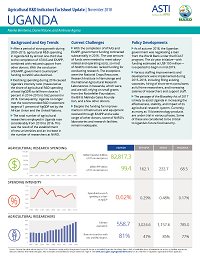Authors:
Nienke Beintema, Daniel Kitone, and Ambrose Agona
Year:
2018
Publisher
International Food Policy Research Institute and National Agricultural Research Organisation
Back to:
BACKGROUND AND KEY TRENDS
- After a period of strong growth during 2000–2015, agricultural R&D spending in Uganda fell by almost one-third due to the completion of ATAAS and EAAPP, combined with reduced support from other donors. With the conclusion of EAAPP, government counterpart funding to NARO also declined.
- Declining spending during 2016 caused Uganda’s intensity ratio (measured as the share of agricultural R&D spending of total AgGDP) to fall from close to 1 percent in 2014–2015 to 0.62 percent in 2016. Consequently, Uganda no longer met the recommended R&D investment target of 1 percent of AgGDP set by the African Union and the United Nations.
- The total number of agricultural researchers employed in Uganda rose considerably from 2010 to 2016. This was the result of the establishment of new universities and an increase in the number of researchers at NARO.
CURRENT CHALLENGES
- With the completion of ATAAS and EAAPP, government funding contracted substantially in 2016. The vast amount of funds were needed to meet salary-related and operating costs, so most of NARO’s institutes lacked funding for conducting research. The exceptions were the National Crops Resources Research Institute in Namulonge and the National Agricultural Research Laboratories in Kawanda, which were, and are still, relying on small grants from the Rockefeller Foundation, the Bill & Melinda Gates Foundation, and a few other donors.
- Despite the funding for improv-ments in infrastructure and equipment received through EAAPP and a wide range of other donors, some of NARO’s laboratories and research facilities remain inadequate.
POLICY DEVELOPMENTS
- As of autumn 2018, the Ugandan government was negotiating a loan from the World Bank under the ECAAT program. The six-year initiative—with funding estimated at US$ 100 million— is expected to begin in mid-2019.
- Various staffing improvements and development were implemented during 2015–2016, including filling existing vacancies, hiring of short-term consultants as full-time researchers, and increasing salaries of researchers and support staff
- The passage of the Biosafety Act of 2017 is likely to assist Uganda in increasing the effectiveness, stability, and impact of its agricultural research system. Currently, as many as 15 biotechnology products are under trial in various phases. Some of these are considered to be critical to Uganda’s future food security.

